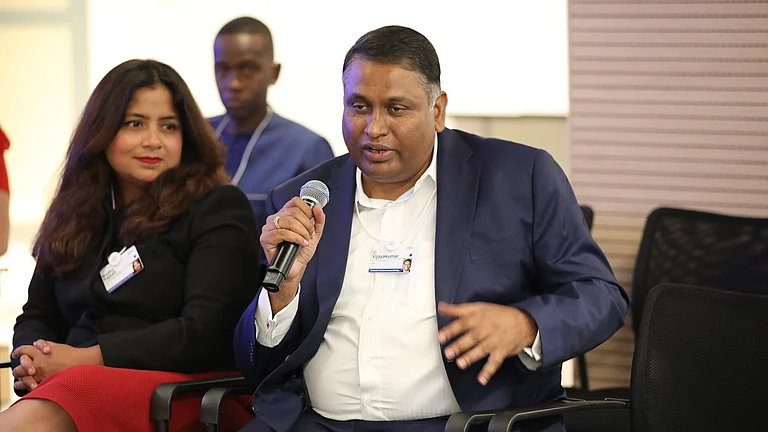Little Rann of Kutch, in the far corner of Gujarat, is 5,000 square kilometre of vastness where nothing grows. The land below your feet is flat, parched brown silt. The landscape is frighteningly uniform, there isn’t a minor slope or a major ridge, just a flat surface that stretches to the horizon.
In this hostile terrain, about 10,000 families engage in the production of salt. From October to April, men, women and children leave their homes in the village and come to the desert. Each family has its own salt pans — little ponds that hold water — on land that is passed on from one generation to the other. They pump water from below the ground and in a painful and highly labour-intensive process, channelise this water from one pan to the other, until salt crystals form. It is hard work — the salt pan workers or agariyas as they are called in Gujarati — stand constantly in brackish water. The temperature in the desert goes as low as three degrees in winter and as high as 50 degrees in summer. The wind speed is so high that anything that is not weighed down to the ground disappears.
Every year, just before Janmashtami, the agariyas borrow money from salt traders — ₹5,000-10,000 depending on the number of pumps they have. At this time, they fix the price of salt that will be produced eight months hence. The first instalment of money is used to repair the pans. Then by October, they borrow money for diesel to run the pumps. They require about 5-7 litres of diesel a pump a day. That’s ₹350 per pump per day. With this they start production. Every two months, they borrow more money — for diesel, food and other expenses. In April, when the salt is produced, they sell it to the trader at the price determined the previous August. Whatever pittance remains after deducting the loans is taken as earnings for the year. That story is changing with the entry of Sabras.
Combining cause and commerce
The founder of Sabras, Rajesh Shah, is an architect by training. At the beginning of his career, he went searching for answers on how he could use his skills for the larger good of the society.
In 1978, he set up Vikas, a non-governmental organisation working with urban and rural poor, and later SAVE, a for-proft social enterprise that provides technological and marketing services to the poor living in coastal Gujarat. But it was in 2002, while working on a research project for Care India that Shah understood the harsh realities of how the agariyas live and work.
He decided that the only way to uplift them from their poverty was to offer them a market-oriented solution. Shah set up Sabras in 2006 as a subsidiary of SAVE, with the intention of bringing in some technological innovation as well as freeing the agariyas from the bondage of the trader. “I pointed out to them that people who have been dealing in salt are becoming rich but producers are still dirt poor. And yet, these people who are benefiting would not have a business to run if the agariyas didn’t produce the salt.
The producers didn’t understand everything I said, but about 40 of them were willing to see if anything could come of this,” Shah says. In 2007, Sabras came to life with Shah investing ₹26,000 for a 26% stake and a group of 40 agariyas chipping in with the rest. Initially, Sabras’ aim was to procure, process and market services from small scale salt workers. Premjibhai was one of these 40 agariyas and today he has no regrets about signing up to be a part of the company.
He has two pumps, two salt pans and produces about 1,500 metric tonnes of salt a year. “I joined Sabras because I wanted to be a trader myself. Traders don’t just exploit us by fixing the price eight months in advance, but cheat us at every stage subsequently. When they take delivery, they cheat us on the weight of the salt and also add all kinds of further cuts to prices. Sabras does not do that and it also buys salt at ₹20-30 per ton higher than the traders,” he says.
Shah realised that the reason agariyas were so vulnerable to being exploited by the traders was the fact that they had to borrow money from the traders to buy diesel for running the pumps — the most expensive part of producing salt. So, he got an engineer to work on a solar model of the pump. Help came from Nabard, which sanctioned a loan of #6 lakh under the Rural Innovation Fund. They used this to build the pump and test it. It worked perfectly well.
In the meantime, Shah was selected as a finalist for Sankalp, a business idea competition run by impact investor, Avishkar Fund. He got some publicity and also met someone from philanthropic foundation Dasra. He attended a course organised by Dasra that taught social entrepreneurs to navigate the business world. At the end of the course, Sabras won an award of $75,000. This formed the working capital of the company.
Two revenue streams
In FY11, Sabras began selling solar-powered pumps to the agariyas. The cost is high though — 10 times that of a diesel pump: ₹2.65 lakh against ₹25,000. But Sabras is offering agariyas three years to pay this sum, at 12% interest. On an average, the solar pump helps the agariya save about ₹72,000 a year on diesel costs. There are about 10,000 diesel pumps in the desert today and Sabras’ idea is to eventually run all of these pumps on solar energy.
Bharatbhai Babubhai is an agariya who produces about 9,000 metric tonnes of salt every year. Last year, he bought a solar pump from Sabras. “The benefits have been many. We didn’t have to borrow money for diesel and because of that, we could fix the price of the salt in April this year — when our stock was ready — rather than August last year. So we got about ₹330 per tonne as against ₹230 per tonne,” he says. This year, Babubhai plans to buy one more solar pump. This ability to spot fix the price of the salt is the biggest advantage that the solar pumps bestow on the agariyas.
In July, this year, Sabras also kicked off its other line of business — branding and distributing its own salt. Priced at ₹10 for a kilo, the first product out of the doors is Sabras Plus and this is being targeted at rural markets. For the current year, Sabras is projecting revenues of ₹35 lakh, with the entire income coming from the sale of solar pumps. Going ahead, Shah sees bigger traction in retailing salt. The test market of Sabras Plus has shown encouraging results. And with the early buyers of solar pumps endorsing the economic benefit of it, the long road to the desert has just begun for Shah and Sabras.






















